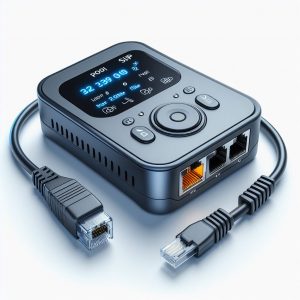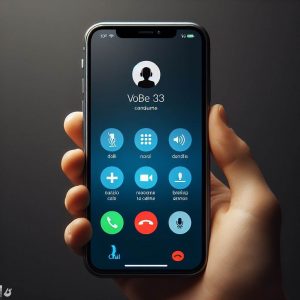I. Introduction
Explanation of VoIP and its benefits
VoIP or Voice over Internet Protocol refers to technologies that allow voice calls to be made over internet data networks instead of dedicated phone lines. VoIP converts analog voice signals into digital data packets that are transmitted over the internet.
Key benefits of switching to VoIP for businesses include:
- Cost savings – Routing calls over the internet avoids long distance and interconnect fees charged by traditional telephone networks. Shared IP infrastructure is less expensive.
- Unified communications – VoIP allows bringing together voice, video conferencing, instant messaging, mobility solutions on one platform.
- Increased mobility – Software VoIP clients allow connecting laptops and mobile devices to the business phone system from anywhere.
- Flexibility – It’s easy to add, remove or transfer lines, and add features with just software changes. No new wiring needed.
- Advanced capabilities – VoIP enables intelligent call routing, auto-attendants, interactive voice response, call analytics and more.
Importance of fax in certain industries
While VoIP adoption has accelerated rapidly, faxing remains crucial for certain industries that rely on fax for legal documentation, healthcare records, invoices and more. Industries that still depend heavily on fax include:
- Legal – Law firms send and receive legal filings, court documents via fax daily.
- Healthcare – Patient records, lab reports, prescriptions often transmitted by fax.
- Banking – Applications, contracts and other financial documents routinely sent by fax.
- Mortgage – Loan applications, bank statements and approval documents need faxing.
- Government – Fax still used for official communications in government.
Ensuring reliable fax capabilities remains vital even when updating communications infrastructure to VoIP across these industries.

II. Challenges of Faxing over VoIP
While VoIP brings tremendous benefits, faxing with VoIP networks poses some specific challenges including:
Sensitivity to delay variation in the audio path
Fax transmissions rely on constant smooth audio frequencies to transmit data reliably. Packet networks can sometimes encounter jitter which is variations in latency. This jitter disrupts the steady audio frequencies needed for clean fax transmissions.
Even small variations in network delays can severely impact fax completeness. As a real-time transmission method, faxing has little tolerance for jitter and fluctuating network conditions compared to other types of data.
Incompatibility of fax machines with VoIP lines
Most traditional fax machines are designed to work via built-in modulation/demodulation transmitting over analog phone lines. They do not natively work when directly connected to digital VoIP lines which use packet-switching instead.
This creates incompatibility issues since the fax modem fails to establish connections, receive handshaking signals and transmit data properly over the VoIP line’s digital packets.
Limitations of Fax over IP services
Some hosted FoIP providers convert received faxes into PDF documents. But for legal and compliance needs, industries like healthcare and finance need the actual fax document with its ink signatures, letterheads, footers preserved intact with full fidelity.
Also, simpler FoIP services lack enterprise-grade security, quality of service guarantees, reliability capabilities and configurability required by organizations that depend heavily on fax.

III. Solutions for Faxing over VoIP
Fortunately there are some effective solutions available for organizations to overcome the challenges and integrate fax machines with VoIP phone systems:
Analog Telephone Adapter (ATA)
A basic solution is to use an analog telephone adapter (ATA). This device converts the analog fax signal into the digital data packets required for transmission over the IP network.
The ATA acts as the bridge allowing the fax machine to connect to the VoIP phone line. It handles the codec modulation and packetization process while also providing dial tone to the fax device.
T.38 protocol for sending faxes over the Internet
T.38 is an ITU standard protocol that defines how real-time Group 3 fax transmissions can be supported over IP networks.
VoIP providers that support T.38 can enable their customers to continue sending and receiving faxes reliably after transitioning to VoIP lines. T.38 provides advanced capabilities to optimize faxing over IP.
FoIP solutions for adapting fax technology to be used over VoIP
Dedicated enterprise-grade fax servers provide fax over IP capability while overcoming the challenges of faxing over VoIP networks. These solutions adapt fax transmissions to work properly over the IP environment.
Enterprise FoIP servers integrate tightly with PBX systems while giving administrators control over fax settings and configurations for optimal performance and compliance.
IV. Best Practices for Connecting Faxes to IP Networks
To leverage the above solutions most effectively, businesses should follow best practices when integrating fax machines with VoIP:
Integration of fax machines into VoIP networks
It’s recommended to use analog telephone adapters or fax over IP servers purpose-built for faxing when connecting fax machines to VoIP networks. This properly handles conversion of the fax signal for reliable transmission over IP.
Disabling error correction mechanisms
Most traditional fax machines rely on error correction protocols. However, these mechanisms are designed for analog lines and can worsen transmission issues over VoIP’s packet-based networks. Where possible, disable error correction when transmitting over IP.
Maintaining an analog line and traditional fax machine for reliable and consistent faxing
For industries that require highly reliable and compliance-grade faxing, best practice is to maintain legacy analog phone lines just for your physical fax machines. This leaves an always-available fax solution unaffected by VoIP network traffic or jitter.
Additional best practices for faxing over VoIP include:
- Using high-quality low compression codecs like G.711 to preserve fax signal quality.
- Implementing Quality of Service policies that prioritize fax traffic on VoIP networks.
- Careful network design and capacity planning to minimize latency and jitter.
- Following manufacturer guidelines for any fax over IP servers or adapters deployed.

V. Conclusion
Assessment of faxing needs to select the best option for businesses
The ideal fax over VoIP solution for any business depends on factors like required reliability, fax transmission frequency, compliance needs, infrastructure and budget.
Light fax users may do fine with analog telephone adapters while heavy faxing loads demand enterprise-grade FoIP servers with advanced monitoring and quality of service.
Importance of reliable and consistent faxing in certain industries
For legal, healthcare, government and other industries that depend heavily on faxes, maintaining reliability and integrity is crucial when transmitting documents like medical records or legal filings.
In these cases, maintaining legacy analog phone lines solely dedicated for physical fax machines may be the optimal hybrid solution even when the rest of communications move to VoIP.
Overall, integrating faxes with VoIP networks is achievable with the right solutions tailored to each organization’s specific requirements. Careful planning ensures VoIP can support the continued need for reliable fax communications even as infrastructure evolves.
1. Introduction to VoipStunt
VoipStunt is a Voice over IP (VoIP) service that provides free calling between VoipStunt users over the internet. The service is powered by Finarea SA, a Swiss-based telecommunications provider.
Brief overview of VoipStunt and its services
VoipStunt allows registered users to make free VoIP calls to other VoipStunt users worldwide. Calls are made using VoIP technology that sends voice conversations digitally over the internet.
Key features offered by VoipStunt are:
- Free calls between VoipStunt members over the internet
- Softphone apps for making VoIP calls directly from PCs and laptops
- Compatibility with most SIP clients and IP phones for hardware VoIP calling
- Instant messaging and presence capabilities
Mention its association with Finarea SA
VoipStunt is owned and operated by Finarea SA, which is a Switzerland-based telecommunications provider focusing on international VoIP services. Finarea operates the network infrastructure and services powering VoipStunt’s offerings.
2. VoipStunt Features
Free calling services to online friends
The main feature of VoipStunt is free VoIP calling between registered members. Users can add friends and family to their contact list to call them for free over the internet using VoipStunt.
It essentially provides unlimited free calling minutes between VoipStunt users worldwide.
Compatibility with softphone and standard SIP clients
In addition to its own softphone apps for Windows and Mac, VoipStunt is compatible with most standard SIP clients and VoIP devices that support the SIP protocol.
This allows using VoipStunt with IP desk phones, VoIP adapters, SIP apps on smartphones and more.
Supported codecs and protocols
VoipStunt supports common voice and video codecs like G.711, G.722, G.729 for audio calls in HD quality. For video calls, it supports H.264 codec.
For call signaling, it uses SIP and IAX protocols for establishing media sessions between devices.

3. VoipStunt for Windows
Details about the VoipStunt application for Windows
VoipStunt offers a dedicated softphone application for Windows PCs that allows making VoIP calls directly from within the app.
Key features of the Windows softphone are:
- User-friendly interface for easy calling
- Contacts list synchronization
- Call management features like mute, hold and transfer
- Instant messaging capabilities
- Presence indicator to see who’s available
Basic information for users intending to use the Windows app
The VoipStunt Windows softphone provides an easy way for users to get started with VoIP calling through the app. It can be downloaded and installed quickly on Windows PCs. Users simply need to create a VoipStunt account online, add their contacts, and start making calls via the app.
4. Download and Installation
Steps to download and install VoipStunt on various platforms
Windows
- Go to voipstunt.com and click on the Download button
- Choose the Windows softphone installer option
- Run the downloaded setup file and follow the installation wizard
Mac
- Go to voipstunt.com and click on Mac softphone download
- Open the .dmg file and drag the VoipStunt app to Applications
- Launch VoipStunt from the Apps folder
Mobile
- For Android and iOS, search for “VoipStunt” in the respective app stores
- Download and install the VoipStunt app
- Alternatively, use Zoiper or other SIP client apps
System requirements for the application
VoipStunt requires the following minimum system configuration:
- Windows 7 or higher / MacOS 10.9 or higher
- At least 2 GB RAM
- Broadband internet connection
- Microphone and speaker for audio calls
- Webcam for video calling (optional)
It works on both desktops and laptops running the required OS version.
5. VoipStunt Comparison
Comparison with other VoIP services like Skype
Compared to Skype, the key difference is that VoipStunt provides completely free and unlimited VoIP calling between its members. Skype charges even for calls between Skype users after a certain limit.
VoipStunt also uses open SIP standards instead of a proprietary protocol like Skype. This allows compatibility with a wider range of VoIP software and hardware clients.
Highlighting the differences and unique features of VoipStunt
Some of the differences and unique aspects of VoipStunt are:
- Truly unlimited free calling within the VoipStunt network
- Open SIP standards compared to proprietary protocols like Skype
- Ability to use standard SIP devices and apps instead of vendor locked-in software
- Supports video calls in addition to audio
- Group chat capabilities for conferencing
- BYOD model – can be used with own SIP phones without purchasing proprietary hardware

6. Configuration and Setup
Guidelines for setting up VoipStunt on different devices
Windows PC
- Download and install the VoipStunt Windows app
- Launch the app and enter your VoipStunt credentials
- The app automatically detects audio/video devices
- Add your contacts in the app and start calling
IP Phones
- Create a VoipStunt account if you don’t already have one
- Obtain your VoipStunt SIP credentials from account settings
- Configure the SIP account settings on your IP phone using the above credentials
- Reboot the phone and register your account
- Add contacts and make calls
Mobile
- Install the VoipStunt app from the app store
- Launch the app, enter your credentials and allow requested permissions
- The app will detect mic/camera automatically
- Place calls to other users from within the app
Specific setup instructions for Grandstream HT801 and routers
Grandstream HT801
- Access the web UI at http://ip-address
- Go to Accounts > SIP Account > General Settings
- Configure values for SIP Server, SIP User ID, Authenticate ID, Password
- Click Apply to save settings
- The phone will now register to VoipStunt
VoIP Routers
- Access the router admin interface, go to the VoIP or SIP section
- Enter your VoipStunt credentials into the SIP account fields
- Set transport protocol to UDP/5060
- Click Apply and the adapter will register with VoipStunt
- Connect analog phones to the router to use VoipStunt
7. User Tips and Routing
User tips and important information for using VoipStunt
- Always make sure you are running the latest app version for maximum stability
- For reliable call quality, use headsets instead of speakers and mic
- When traveling, connect only to known good WiFi networks for best performance
- Disable battery optimizations for VoipStunt app in mobile device system settings
- Use a UPS for desktop VoIP devices to avoid call drops during power outages
Routing tips from various users for VoipStunt
- Enabling QoS on your router and giving high priority to VoIP/SIP traffic improves call quality
- Port forwarding UDP 5060 on your router to your VoipStunt device can resolve one-way audio issues
- For desktop devices, use a wired Ethernet connection rather than WiFi whenever possible
- Disable any VoipStunt battery optimization settings on mobile devices for reliable background running
- Reduce concurrent internet usage from apps and devices to allocate more bandwidth for VoipStunt

8. Conclusion
Summary of the key points discussed
- VoipStunt provides unlimited free VoIP calling between its registered users
- It offers Windows and Mac softphone clients along with support for SIP hardphones
- Easy to configure and set up on desktops, mobiles and SIP devices
- Provides modern VoIP features like HD audio/video calling
- Interoperable with hardware and software supporting open SIP standards
Closing remarks about the benefits of using VoipStunt
For people who make frequent international or long distance calls, VoipStunt provides an unparalleled free alternative. Businesses with global teams can use VoipStunt to enable free communication between employees worldwide. VoipStunt epitomizes the power and cost savings inherent in VoIP technology for making unlimited free calls.
Introduction
Asterisk is an open source software implementation of a private branch exchange (PBX) that routes calls like a business phone system. With its built-in support for Voice over IP (VoIP) protocols, Asterisk is a popular and flexible platform used to build VoIP solutions.
Brief overview of Asterisk
Created in 1999 by Mark Spencer, Asterisk is an open source project that provides the core PBX functionality needed for business communications. It is released under the GNU General Public License (GPL) and is free to use.
Asterisk supports an impressive range of telephony capabilities that enable integrating voice, video and other media communications via both VoIP and conventional telephony.
Importance of Asterisk in VoIP solutions
Asterisk plays a pivotal role in delivering VoIP based communications systems due to these key advantages:
- Free open source software makes it budget friendly.
- Modular architecture allows extensive customization and integration.
- Supports key VoIP protocols like SIP, H.323 and others.
- Interoperates with traditional telephony like analog lines and TDM.
- Available on Linux and other platforms with good community support.
These capabilities make Asterisk a versatile platform for deploying customized VoIP solutions from small businesses to large enterprises.
Asterisk: An Open Source PBX
Origins and development of Asterisk
Asterisk was created in 1999 by Mark Spencer as an open source alternative to proprietary PBX systems. It was initially targeted at Linux platforms.
Key milestones in Asterisk’s development include:
- 1999 – First version 1.0 released.
- 2001 – Launch of the Asterisk@Home project for hobbyist VoIP usage.
- 2004 – Asterisk becomes part of Digium and sees widespread enterprise adoption.
- 2006 – Support for IPv6 added to keep pace with evolving networks.
- 2015 – Release of Asterisk 13 adds features like built-in bridges and improved video support.
- 2020 – Asterisk 17 offers WebRTC support, better security and Python 3 migration.
Asterisk continues to be actively developed by the open source community and Digium.
Features and functionality of Asterisk
Some of the main features that make Asterisk a versatile PBX platform are:
- Call switching, management and call queueing.
- Support for multiple VoIP protocols like SIP, IAX2, MGCP, H.323 for unified communications.
- Integrated voicemail, IVR, auto attendant and conference calling.
- Call recording and monitoring capabilities.
- Media processing via codecs like G.711, G.722, G.729 for audio/video calls.
- Interfaces for integration with analog, digital and ISDN telephony.
- APIs for call control integrations using languages like PHP, Python, Java etc.
Interoperability with various VoIP protocols
A key advantage of Asterisk is its support for a range of VoIP protocols:
- SIP – Used for VoIP endpoints like IP phones and SIP trunks.
- IAX – Inter-Asterisk eXchange protocol used internally between Asterisk servers
- H.323 – Popular protocol used in VoIP and video conferencing.
- MGCP – Media Gateway Control Protocol manages media gateways and endpoints.
This multi-protocol support provides flexibility for unified communications.

Asterisk Components
Asterisk consists of several modular components that work together to enable telephony functions:
Asterisk channels: Telephony connections to the PBX
A channel handles a single active call leg and sources audio from the source to the PBX mixer. Some channel types are:
- SIP channels for VoIP endpoints registered to Asterisk via SIP.
- IAX2 channels for interconnecting Asterisk servers internally.
- H.323 channels for interfacing with H.323 hardware devices or gateways.
- Local channels for analog, digital and ISDN lines.
Asterisk H323 channels
The H.323 channel driver provides connectivity to H.323 compliant endpoints like:
- H.323 hardware phones e.g. Polycom, Yealink.
- H.323 VoIP gateways that connect to ISDN and analog lines.
- Video conferencing systems that use H.323.
It handles call signaling and media formats like G.711, G.722, G.729 used with H.323.
Asterisk IAX channels
IAX or Inter-Asterisk Exchange protocol is a lightweight VoIP protocol designed for efficient usage between Asterisk servers. key features are:
- Single UDP port for media and signaling.
- Low bandwidth overhead compared to SIP.
- NAT traversal support.
- Fast call setup.
IAX is well suited for trunk connections between remote Asterisk installations.
Asterisk SIP channels
The SIP channel driver interfaces with endpoints like:
- SIP phones, SIP ATAs supporting analog phones.
- SIP trunks between the Asterisk PBX and telephony providers.
- SIP video doorphones and survillance cameras.
It manages the SIP signaling for call management and provides codec support like G.711, G.722, G.729, Speex etc.
Asterisk Applications
Asterisk enables developing a variety of applications via its APIs and technologies like AGI:
Voice recognition system integration
Using Asterisk’s AGI interface, voice recognition platforms like Amazon Connect, Nuance Mix can be integrated to create IVR solutions, contact centers and more.
Interface with normal telephone lines and ISDN basic rate and primary rate interfaces
Using channel drivers, Asterisk can connect to:
- Analog and digital circuits like POTS, T1/E1/J1.
- ISDN protocols like PRI and BRI.
This allows supporting legacy telephony alongside VoIP.
Advanced services like video telephony and contact center applications
With Asterisk APIs, developers can create solutions like:
- Video conferencing servers supporting SIP and H.323 video endpoints.
- Contact center platforms with call monitoring, whisper, barge-in capabilities.
- Click to call applications using Asterisk’s fast AGI-based dialing.

Asterisk Interoperability
Compatibility with various VoIP hardware and software
Asterisk provides out-of-the-box compatibility with a wide range of endpoints:
- Major SIP phone brands like Polycom, Yealink, Cisco, Grandstream etc.
- SIP analog telephone adapters like Linksys PAP2T, ObiHai, Cisco SPA112 etc.
- SIP intercoms and video door stations from vendors like Commend, 2N, Axis Communications etc.
- Support for gateways that bridge ISDN, analog and digital circuits.
Support for most SIP telephones and other VoIP protocols
In addition to SIP phones, Asterisk supports:
- H.323 endpoints like Polycom and Yealink H.323 handsets.
- Proprietary protocols like Skype for Business.
- WebRTC for browser to phone calling.
Integration with traditional circuit-switching protocols like ISDN and SS7
Asterisk supports legacy protocols used widely in enterprise phone systems:
- ISDN PRI/BRI for connecting legacy PBX systems.
- SS7 for interconnecting phone networks via SIGTRAN.
- Multifrequency signaling used in North America and parts of Asia.
Asterisk Deployment
Benefits of using Asterisk for businesses
Businesses can realize significant benefits by deploying Asterisk:
- Cost savings compared to expensive proprietary PBXs.
- Avoid vendor lock-in due to open standards support.
- Flexibility to customize and integrate with other business apps.
- Scalability from small offices to large multi-site enterprises.
- Control over adding new features and upgrades.
Cost-effectiveness and flexibility for small businesses and large enterprises
Both small businesses and large enterprises find Asterisk attractive:
Small business
- Low startup costs by using free open source software.
- Lean custom solutions instead of bloated PBX features.
Large enterprises
- Drive down infrastructure costs at scale.
- Tightly integrate communications across business processes.
- Connect multi-site Asterisk servers via IAX trunking.
Wide range of add-on products for extended features and capabilities
A vibrant ecosystem of products extend Asterisk functionality:
- Endpoints like IP phones, gateways, SIP trunks.
- UC clients like Zulu and Bria for VoIP roaming.
- Modules for contact center, call recording etc.
- Management and monitoring dashboards.
- Commercial support subscriptions from Digium and others.

Asterisk Development
Open-source software, allowing for customization and integration
As open source software, Asterisk can be customized via:
- Adding modules and patches for new functionality.
- Integration with web apps using Asterisk Gateway Interface (AGI).
- Modifying dialplan configurations for unique call flows.
- Building new Asterisk channels for interfacing with hardware.
Running on various operating systems with technical knowledge
Asterisk runs on several operating systems:
- Linux distributions like RedHat, Debian, CentOS.
- BSD variants like FreeBSD.
- Windows when compiled natively or via WSL.
- Virtualized platforms like VMWare, VirtualBox, Hyper-V.
Technical expertise is needed for installation and management.
Community support and resources for developers
Active forums like /r/asterisk on Reddit and Asterisk Community forum provide peer support. Documentation covers installation, administration and configurations. Certification programs like CPAS provide structured learning. Overall, resources exist for developers to tap into the Asterisk community.
Conclusion
Summary of key points
In summary, Asterisk is an open source PBX that enables deploying customized VoIP solutions from SMBs to large enterprises. Its support for multiple protocols, ability to integrate with legacy systems and open source accessibility make Asterisk a highly capable platform for VoIP.
Future development and prospects of Asterisk in the VoIP industry
Asterisk will continue evolving with new versions adding features and improvements. Adoption is expected to keep rising as organizations look to open standards for avoiding vendor lock-in. With strong community support, interoperability and scalability, Asterisk has bright prospects to remain a leading open source force in the VoIP industry.
I. Introduction to T-Mobile VoIP
Definition of VoIP (Voice over Internet Protocol)
VoIP or Voice over Internet Protocol refers to communication technologies that allow making voice calls over an internet connection instead of traditional phone lines. VoIP converts analog voice signals into digital data packets that can be transmitted over the internet. At the receiving end, the packets are decoded back into analog signals.
VoIP allows providing voice services more efficiently using shared network infrastructure. Call quality can rival conventional landline phones with modern networks.
T-Mobile’s use of VoIP technology in its services
As one of the largest mobile carriers in the US, T-Mobile utilizes VoIP in various offerings to deliver voice services over data networks. This includes:
- T-Mobile LineLink service which relies on VoIP technology.
- Partnership with Ooma for expanding VoIP based home phone options.
- Expanding VoIP capabilities on T-Mobile’s cellular and home internet plans.
- Upgrading network infrastructure for delivering VoIP calls more efficiently.
VoIP is a strategic technology for T-Mobile as it transitions voice services to run over broadband and mobile data.

II. T-Mobile VoIP Services
Description of T-Mobile LineLink
T-Mobile LineLink is a home phone service offered by T-Mobile using VoIP technology:
Overview and features
LineLink aims to provide a low cost but full-featured home phone service on T-Mobile’s network using VoIP. It offers unlimited local and domestic long distance calling.
Key features include:
- WiFi calling capabilities – Make calls over WiFi when cellular coverage is weak.
- HD voice for improved clarity.
- Visual voicemail support.
- Calling features like call forwarding, waiting, conferencing and more.
Connection to the T-Mobile network with VoIP technology
LineLink works by connecting a physical adapter device to the customer’s broadband router via Ethernet. This Analog Telephone Adapter (ATA) links up traditional home phone devices to T-Mobile’s IP network.
The ATA converts analog voice signals from the regular phones to digital packets for transmission over the internet using VoIP. These packets are routed to T-Mobile’s servers which connect the call. VoIP enables delivering the home phone service efficiently over broadband.
Calling features and limitations
LineLink delivers modern calling capabilities backed by T-Mobile’s network:
- Unlimited nationwide calling without long distance charges.
- Basic features like caller ID, call forwarding, 911 access are included.
- International calling is available at extra cost per minute.
- Number porting is available to transfer an existing number to LineLink.
- There are some limitations compared to full cellular plans. For example, no roaming, limited 911 locating, etc.
Requirements for using LineLink
To use LineLink, users need:
- A compatible analog phone
- T-Mobile’s Analog Telephone Adapter device
- High speed home internet connection
- A T-Mobile LineLink plan subscription
With these elements, customers can use their regular home phones over T-Mobile’s VoIP network.
Partnership with Ooma
T-Mobile has partnered with Ooma, one of the leading VoIP network providers, to expand its VoIP services:
Highlighting the strength of the partnership
The Ooma partnership allows T-Mobile to tap into the capabilities of one of the most advanced VoIP networks to strengthen its offerings. Specifically:
- Ooma provides the underlying network for T-Mobile’s LineLink service.
- The partnership also allows T-Mobile customers preferred pricing on Ooma’s VoIP equipment like the Ooma Telo.
- T-Mobile customers can subscribe to Ooma home phone packages at reduced pricing.
This creates a win-win partnership where both companies can grow their VoIP customer base.
Expected growth from the reselling deal
By reselling Ooma’s services, T-Mobile can drive further growth in its home phone offerings without large infrastructure investments. Ooma benefits from accessing T-Mobile’s marketing resources and customer reach.
The success of LineLink and continued partnership shows the increasing strategic importance of VoIP services for T-Mobile’s growth. Expanding VoIP offerings is expected to appeal to cord-cutting households looking for flexible home phone options.
T-Mobile Home Internet and VoIP
T-Mobile’s emerging home internet service also intersects with VoIP capabilities:
User experiences with VoIP devices on T-Mobile home internet
Many customers pairing T-Mobile Home Internet with VoIP devices for home phone service report positive experiences. The home internet plans provide plenty of bandwidth for steady VoIP call quality.
Some users mention better call reliability compared to VoIP over cellular. However, individual experiences can vary based on local network conditions.
Issues and solutions related to using VoIP over T-Mobile home internet
Some users have reported issues like:
- Choppy call quality during peak usage or network congestion.
- Difficulty with 911 location accuracy.
- Limitations in using hardware like ATAs with the public IP addresses.
While T-Mobile is working to improve VoIP support, users have found workarounds like:
- Adding a VoIP optimized wireless router to prioritize voice traffic.
- Supplementing VoIP use with cell phones for 911 and reliability.
- Porting numbers to VoIP providers like Google Voice instead of T-Mobile VoIP.
As home internet plans evolve, VoIP call quality is expected to reach parity with conventional options. But currently it requires some technical diligence by customers.

III. Technical Aspects of T-Mobile VoIP
Technical requirements for using T-Mobile VoIP services
To use VoIP services reliably on T-Mobile’s network, some key technical requirements include:
- A broadband internet connection with sufficient bandwidth and low latency. For home use, typically need at least 10 Mbps download speeds.
- VoIP capable devices like IP phones, ATAs, or VoIP apps.
- For ATAs, an active T-Mobile SIM is required along with compatible unlocked devices.
- IP addresses should be public-facing rather than behind NAT to avoid issues.
- Port forwarding correctly configured on the home router for the VoIP device.
- WiFi connectivity in areas where cellular network is weak.
Meeting these requirements provides the foundation for good call quality on T-Mobile’s VoIP platform.
Whitelisting of IPv4 address blocks
T-Mobile provides documentation for whitelisting IP blocks to prioritize traffic from VoIP devices. This improves call quality and reliability for services like LineLink.
The IP blocks are updated regularly as T-Mobile enhances network infrastructure for VoIP. Admins should check the latest whitelist requirements and configure firewalls appropriately.
Setup and troubleshooting of T-Mobile VoIP devices
End user documentation is provided for setting up services like LineLink with the ATA adapters. This covers:
- Connecting adapter to home router and analog phone devices.
- Activating T-Mobile SIM card and associating with LineLink number.
- Configuring WiFi and testing connectivity.
- Troubleshooting steps if calls fail or quality is poor.
For advanced network troubleshooting, tools like ping, traceroute help verify connectivity between the user’s environment and T-Mobile’s VoIP endpoints.
Overall, T-Mobile aims to make the service plug-and-play but some technical diligence ensures optimal functioning.
IV. Regulatory and Compliance Aspects
FCC regulations and the transition from POTS to VoIP
The FCC regulates VoIP services to ensure standards like:
- 911 access and location accuracy.
- Disability access and video relay capabilities.
- Protecting consumer privacy and call records.
- Legal intercept capabilities and CALEA compliance.
As wireline POTS transitions to VoIP, providers like T-Mobile must update solutions to meet the same requirements such as E911.
T-Mobile’s compliance with VoIP-related regulations
T-Mobile keeps up with evolving VoIP regulations:
- It provides E911 access on VoIP services but warns limitations compared to 911 on cellular.
- It supports disability access like video relay services over VoIP.
- They issue transparency reports on information disclosure and legal requests.
Staying compliant allows T-Mobile to responsibly transition POTS lines to regulated VoIP services.
Emergency service and 911 access for T-Mobile VoIP users
T-Mobile provides 911 access on VoIP services but highlights that location accuracy may be limited compared to cell network 911:
- For LineLink ATA users, registered service address is used for 911 since devices are stationary.
- For mobile VoIP use over WiFi calling, phone GPS and cell tower location may not be accessible.
Users should be aware of potential E911 limitations depending on how T-Mobile VoIP services are being accessed.

V. Business Solutions and Collaboration
T-Mobile’s VoIP offerings for businesses
T-Mobile caters to business needs by enabling VoIP integrations on its cellular plans:
- Integrated business communications from Broadsoft, Mitel and other platforms.
- IP PBX systems can integrate with cellular for unified communications.
- WiFi calling and VoLTE support reliable VoIP on mobile devices.
- Dedicated support resources for enterprise accounts and network needs.
Cloud communication and collaboration tools provided by T-Mobile
Additionally, T-Mobile partners with third-party cloud business phone providers that utilize VoIP technology for advanced capabilities:
- Integrated phone, conferencing, contact center and other tools.
- Flexibility to use desktop or mobile apps along with desk phones.
- AI powered features like real-time translation, automated attendants etc.
VoIP integration enables T-Mobile to deliver complete network solutions for organizations.
VI. Conclusion
Summary of T-Mobile’s VoIP services and their implications
T-Mobile is clearly embracing VoIP technology to gradually transition its voice services away from legacy networks. Offerings like LineLink, Ooma partnership and improving cellular VoIP demonstrate this strategic direction.
For consumers, it aims to provide more flexible home phone options beyond traditional landlines. For businesses, VoIP integration enables cloud communications and mobility.
Future prospects and developments in T-Mobile’s VoIP offerings
T-Mobile is expected to expand its VoIP portfolio as it continues enhancing its IP network capabilities. More unified communication features will get integrated into cellular plans. Partnerships with communication app vendors could bring VoIP powered integration.
With 5G scaling up, VoIP over mobile data will become even more viable. T-Mobile is poised to lead mobile carriers in leveraging VoIP to disrupt traditional voice services. While technical challenges persist, the long-term outlook remains bright.
I. Introduction
A. Definition of VoIP Adapter
A VoIP (Voice over Internet Protocol) phone adapter, also known as an analog telephone adapter (ATA), is a device that allows you to use traditional analog phones, fax machines, and other analog devices on digital Voice over Internet Protocol (VoIP) phone networks. The adapter converts analog signals into digital data that can be transmitted over the internet, and vice versa.
B. Importance in bridging analog and digital networks
VoIP adapters play a crucial role in bridging legacy analog telephone systems with modern digital VoIP networks. As businesses transition their phone systems to VoIP for cost savings and advanced capabilities, VoIP adapters allow them to continue using existing analog phones, fax machines, modems, and other analog devices that rely on traditional telephone networks. The adapters seamlessly integrate these devices into the new digital systems. VoIP adapters also enable consumers to use their regular home phones with VoIP services provided by their cable company or third party providers. Overall, VoIP adapters facilitate the adoption of VoIP technology by enabling backwards compatibility.
II. What is a VoIP Adapter?
A. Functionality
1. Bridging analog and digital signals
The core functionality of a VoIP adapter is to bridge the gap between analog and digital voice communications. It provides the following signal conversions:
- Analog (voice, fax) to digital – The VoIP adapter takes the analog audio signals from traditional phones and converts them into digital packets that can be transmitted over the internet. This allows sending and receiving calls over VoIP networks.
- Digital to analog – In the other direction, the adapter converts the digital VoIP audio back into analog signals that can be output by conventional phones. This allows analog phones to receive VoIP calls.
2. Connecting analog devices to VoIP services
VoIP adapters allow analog telephones, fax machines, modems and other analog equipment to access and use VoIP phone services. This includes:
- Connecting regular home phones to residential VoIP services like those from cable providers
- Integrating office analog phones and fax machines with business VoIP phone systems
- Enabling analog devices to utilize VoIP features like call routing, voicemail to email, call recording and more.
B. Technical overview
1. Connection to local area network
VoIP adapters connect to the local area network via an ethernet port or WiFi. This allows them to access the VoIP phone system which is normally hosted on a private business network or by a residential VoIP provider. The adapter links analog devices to the same network.
2. Integration with analog phone systems
The VoIP adapter integrates with existing analog telephone systems using RJ-11 FXS (“foreign exchange station”) ports. Analog phones or other devices plug directly into the FXS ports on the adapter using standard telephone cables. Multiple ports allow connecting multiple analog devices. The adapter appears just like a regular phone line to the attached analog equipment.

III. How Does a VoIP Adapter Work?
A. Signal conversion process
1. Analog to digital and vice versa
VoIP adapters work by converting analog signals to digital packets, and vice versa:
- Analog to digital: The adapter takes the analog voice signal from a traditional phone handset and converts it into a digital signal using a codec (coder-decoder). This digitizes the voice so it can be assembled into IP packets and transmitted over the internet. Popular codecs used by VoIP adapters include G.711, G.729 and G.722.
- Digital to analog: In the reverse direction, the incoming digital VoIP data (packets) from the network are extracted by the adapter and decoded back into an analog voice signal using the codec. This analog signal can then be output to a regular phone handset to be heard by the recipient.
This bidirectional conversion between analog and digital domains is what allows the two technologies to interconnect and talk to each other.
B. Integration with VoIP systems
1. Call routing and queuing for efficiency
VoIP adapters seamlessly integrate with VoIP phone systems to enable efficient call routing and management:
- When an analog phone connected to the adapter makes a call, the adapter forwards the signaling and digitized voice data to the VoIP phone system.
- The VoIP system handles call routing, call switching, call forwarding, dial plans and other call management features.
- During high call volumes, calls may be queued and switched efficiently using the VoIP system before sending the voice signals back to the adapter for analog output.
- The adapter essentially acts as an analog end-point for the digital VoIP network while handling the analog to digital conversion.
This tight integration allows businesses to retain the flexibility and features of their VoIP phone systems while getting analog devices online.
IV. Types of VoIP Adapters
There are two main types of VoIP adapters used to connect analog devices to VoIP networks:
A. Analog Telephone Adapter (ATA)
An analog telephone adapter (ATA) is a device that acts as a gateway to connect one or more standard analog phones to a VoIP network. It is the most common and cost-effective type of VoIP adapter used by residential customers and small businesses.
Key features of an ATA include:
- RJ-11 FXS ports to connect analog phones using regular phone cables
- RJ-45 ethernet port to connect to a router or modem for VoIP network access
- Built-in codec to convert signals between analog and digital formats
- Dial tone simulation to make the VoIP system seem like a normal phone line
- Call features like call waiting, caller ID, call forwarding etc.
Popular ATAs include the Linksys PAP2, Obihai OBi200, Cisco SPA112, Grandstream HT802 etc. ATAs are sold by VoIP providers or purchased standalone. They aim to be simple plug-and-play devices for easy analog phone usage over VoIP.
B. SIP Adapter vs. VoIP Gateway
For larger businesses with PBX phone systems, the choice is between a SIP adapter or VoIP gateway to integrate analog devices:
1. Technical capabilities and cost-effectiveness
SIP Adapter
- Designed for use with SIP (Session Initiation Protocol) based VoIP PBX systems
- Acts as a SIP endpoint registering directly to the SIP PBX
- Handles SIP signaling and voice digitization
- Cost-effective solution for small to medium business needs
VoIP Gateway
- More advanced capabilities compared to a SIP adapter
- Can register multiple SIP endpoints from various analog devices
- Extra features like local voice switching without sending data to the IP PBX
- More expensive but can handle larger numbers of device integrations
Generally, SIP adapters are used by small businesses while large enterprises use VoIP gateways to integrate their legacy analog infrastructure. The right solution depends on the technical needs and budget.

V. Using VoIP Adapter with Wireless Network
A. Benefits of wireless connectivity
Using a VoIP adapter over WiFi and wireless networks provides benefits like:
- Flexibility – Phones can be used without stranded wires running through the building. Users can move around while on voice/video calls.
- Cost savings – No need for rewiring or installing ethernet cables to use VoIP adapters. WiFi is generally already available.
- Scalability – Its easy to add more analog phones by just plugging into available adapters. No need to run additional wires or cables.
B. Tips for seamless integration
1. Utilizing wireless bridges for stability
For best performance, plug the VoIP adapter into a wireless bridge connected to the WiFi router rather than connecting directly. Wireless bridges provide a stronger and more stable signal which is important for VoIP call quality.
2. Connecting IP phones for cost-effective calling
Combine analog adapters with a few VoIP wireless IP phones. IP phones allow making VoIP-to-VoIP calls within the network at no cost without needing the analog conversion. This reduces load on the limited adapters.

VI. Conclusion
A. Growing importance of VoIP adapters in residential and business settings
As Voice over IP technology becomes ubiquitous, VoIP adapters play a crucial role in facilitating the transition from legacy analog systems to digital VoIP networks. The adapters allow consumers and businesses to retain their analog phones, faxes and other gear while migrating phone systems to VoIP for enhanced capabilities. VoIP adapter use will continue growing both in homes and enterprises.
B. Future prospects and advancements in VoIP technology
VoIP adapter technology will evolve along with VoIP networks. Adapters will add support for newer protocols like WebRTC along with improved codecs for HD voice quality. Configurations will be increasingly automated using TR-069 and zero-touch provisioning. As VoIP services spread globally, more options will become available from leading vendors. With strong prospects ahead, the ordinary analog adapter will continue playing an extraordinary role in the digital revolution.
-
Introduction
Voice over Internet Protocol (VoIP) has revolutionized communication by allowing users to make phone calls over the internet instead of traditional telephone lines. For iPhone users, VoIP unlocks a host of useful features for both personal and professional needs. From inexpensive international calls to seamless integration with your iPhone’s native dialer app, VoIP empowers iPhone users with flexibility and functionality.
With the right VoIP app, iPhone users can benefit from HD sound quality on calls, video conferencing, screen sharing, instant messaging, call recording/logging, and other powerful communication tools. VoIP services integrate tightly with your iPhone contacts and call history, providing one cohesive experience. Many VoIP apps also allow you to use your iPhone number as your caller ID when making calls over Wi-Fi or cellular data.
For businesses, VoIP apps help teams collaborate through features like group messaging, file sharing, meetings, and more. Companies can maintain a professional image by displaying their business name and logo to recipients. VoIP solutions also enable advanced functionality like intelligent call routing, interactive voice response systems, and cloud phone systems connected to your office’s landline numbers.
Overall, with limitless global connectivity, crystal clear call quality, and robust features for productivity, VoIP apps unlock the potential for iPhone users to communicate better than ever before – both personally and professionally. The rest of this article will explore the top VoIP apps, best practices for calls, business solutions, CallKit integration, and more to help you harness the power of VoIP services on your iPhone.

Making VoIP Calls on iPhones
To start using VoIP services on your iPhone, there are a couple of requirements. First, you will need an app connected to a VoIP provider over Wi-Fi or mobile data. Popular apps include Skype, WhatsApp, Facebook Messenger, Google Voice, and more dedicated business VoIP platforms. Second, for optimal call quality, ensure you have a stable high-speed internet connection for smooth, uninterrupted service.
When ready to make a call, open your preferred VoIP app and dial just like you would on a voice call. Depending on the platform, you can call other users on the same service or phone numbers worldwide. If calling another number, input the full phone number with country code to connect. Enjoy crystal clear sound quality and reliability powered by VoIP technology.
In addition to the apps pre-installed on your iPhone, hundreds of third-party VoIP apps are available for download on the App Store. Popular options include Viber, MagicJack, Fongo, and Line2. These apps allow you to leverage VoIP calling into your existing iPhone calling experience and contacts. Some apps will even assign you a real phone number to use as your caller ID, with the ability to call any number directly from the app. This deep integration makes the process smooth and convenient.
Overall, making VoIP calls on your iPhone is simple with the range of available apps. Just connect to Wi-Fi or cellular data, install your preferred platform, enter a phone number, and enjoy superior call quality at little to no cost. The technology has revolutionized communication around the globe.
III. Best VoIP Apps for iPhone
With dozens of VoIP apps on the App Store, deciphering the best option for your needs can be challenging. To simplify your decision, here is a comparison of the top 10 VoIP apps for iPhone in 2024 based on features, reliability, sound quality, value, and more.
Ooma Office
Ooma Office tops our list as a robust cloud-based phone service for small businesses. It delivers excellent call quality via the iOS app. Features include a virtual multi-line phone system, intelligent call routing, voicemail transcriptions, ring groups, hold music, conference calling, and fax capabilities. At $19.95 per user/month, it provides enterprise-grade tools.
Vonage
For consumers and solopreneurs alike, Vonage stands out as the best overall VoIP app. It offers unlimited talk and text to the US, Canada, Mexico, and more on Wi-Fi. Vonage assigns you a real phone number and seamlessly integrates contacts and call history across devices. With video conferencing, instant messaging, and team messaging, it facilitates easy collaboration. Top-notch customer service and affordable international rates make Vonage well-rounded and versatile for personal use.
Dialpad
Dialpad shines for its artificial intelligence capabilities. The app features real-time speech recognition to transcribe voicemails into text automatically. You can also search call and SMS content for keywords to jog your memory on past conversations. With Slack integration, UberConference video meetings, and intelligent contact profiles, Dialpad leverages AI to streamline team collaboration. At $15 per user/month, it removes friction from communication.
Skype
A pioneer in the VoIP space, Skype continues offering reliable, low-cost global calling pay-as-you-go rates from your iPhone. Features include instant messaging, screen sharing, call recording, group video chats for up to 50 people, and Outlook integration. While more consumer-focused, Skype remains a popular app to connect internationally across platforms.
Google Voice
Google Voice makes it possible to consolidate messaging across devices into one intuitive iOS app. Features include free SMS, MMS picture messaging, voicemail transcripts, call blocking, conference calling, call history syncing, international rates from 1 cent per minute, and intelligent spam call protection. Seamlessly transition calls between your iPhone, iPad connected devices.

Line2
Specifically designed for business owners, Line2 provides a second business line on your iPhone to keep work calls separate from personal ones. Easily toggle between your two numbers on the fly or on a schedule. Features include SMS/MMS messaging, conference calls, call forwarding, voicemail transcription, fax services, and integrations with business software platforms. Plans start at $9.99 per month after a 7-day free trial.
Fongo
For affordable home phone replacement, Fongo allows you to port your existing number to its VoIP service. You can make unlimited nationwide calls and texts to US and Canadian numbers. Features include free phone numbers, voicemail-to-text, call forwarding, conference calling, call blocking, and SMS capabilities. At $9.99/month after a generous free trial, Fongo makes ditching your landline easy and wallet-friendly.
MagicJack
With deep integration into your iPhone’s native Phone app, MagicJack essentially operates as an additional line. It provides unlimited local and long distance calling. Features include free phone numbers, voicemail, call waiting, call forwarding, 411 directory access, conference calling, and video messages for $2.99 per month. MagicJack also sells pre-paid international minutes starting at $10 for 240 minutes.
SnapDial
SnapDial focuses purely on delivering lowest cost international calling starting at 1 cent per minute. Make affordable calls to landline numbers in over 200 countries. Features include in-app calling minutes top-up, SMS messaging, call history, iPhone contacts syncing, and free number transfer into the app. SnapDial provides budget-friendly global connectivity.
Talkatone
Lastly, for a completely free option, Talkatone provides basic VoIP functionality with no hidden fees. Features include free calls within the US, call forwarding, conference calling, SMS messaging, voicemail boxes, and free number assignment. As an ad-supported app, Talkatone does show promotions but is fully functional for simple calling needs.
In summary, when choosing a VoIP app for iPhone, weigh your priorities like business solutions vs personal use, advanced functions like video conferences, number porting capabilities, international call rates, and overall value for money based on functionality. Any app above will serve you well, with Vonage striking the best balance as an affordable and fully-featured option for consumers. Enjoy exploring VoIP capabilities on your iPhone!
VoIP Solutions for Business Communication
For business owners, VoIP apps unlock powerful potential for empowering team collaboration on iPhones. Instead of traditional PBX landline systems, VoIP facilitates mobile-first cloud phone solutions accessed through convenient iOS apps. Features like intelligent call routing, multi-line support, real-time call analytics, voicemail transcriptions, SMS capabilities, instant messaging, video meetings, and more streamline communication.
VoIP apps also nurture stronger client relationships by providing call forwarding, interactive voice responses, detailed call logs, and screen recording tests for customer support. For effective internal communication, team messaging keeps all discussions centralized for reference. File sharing eliminates version chaos from long email chains. Video conferences enable productive meetings on the go versus being deskbound.
With VoIP business apps, iPhone users maintain a professional image with branded caller IDs featuring your logo, tagline, employee names, and contact information for recipients. Keep work calls separate from personal lines or leverage number masking to protect privacy. For organizations without receptionists, intelligent call routing based on menus or office hours facilitates self-service for customers to the right department.
For cost management, VoIP solutions provide reliable unlimited national calling with free internal communication between employees. International rates are significantly lower than traditional providers, saving your business money abroad. Call analytics also control expenses by reporting metrics like peak call times to inform optimal staffing needs versus wasted energy during slow periods.
Overall, by leveraging VoIP apps tailored for business, companies streamline teamwork, nurture customer relationships, maintain professionalism, route calls intelligently, drive profits with cost savings, and equip organizations with mobility. For iPhone users, VoIP facilitates easier collaboration sans office desk phones, aligning with flexible remote work arrangements. Sample platforms include Ooma Office, Dialpad, Line2, RingCentral, Aircall, eVoice, and Grasshopper. Embrace the potential to communicate faster and smarter using VoIP solutions for business.

Using CallKit for VoIP Calls
For VoIP apps providing core calling capabilities, Apple provides the CallKit framework for deeper iPhone integration. By tapping into CallKit functionality in iOS, VoIP apps can provide native dialer experiences, recent call display in the Phone app, contact matching, handover between Wi-Fi and cellular, spatial audio for calls, and more.
Essentially, CallKit allows your custom VoIP app experience to blend seamlessly with default iPhone calling habits. Instead of separate apps and call histories, CallKit enables VoIP platforms to fully customize the native Phone app workflow itself.
For example, when receiving a VoIP call using CallKit, it will look and behave exactly like a regular iPhone call with integrated notification prompts, sounds and haptics. Users don’t need to memorize new behaviors. CallKit also facilitates number masking easily so your main iPhone number can display as the caller ID for VoIP calls instead of random app IDs.
During an active VoIP call leveraging CallKit, you can fluidly transition between Wi-Fi and mobile data networks if moving locations or if internet quality drops. The receiver simply continues an uninterrupted call experience as the transport layer switches behind the scenes. CallKit also enables proper TTY mode and reporting for call statistics like routed calls versus unanswered ones.
Overall for developers, building VoIP apps, CallKit integration ensures the default iPhone calling experience shines through. This facilitates mass user adoption for platforms looking to scale who don’t expect users to memorize complicated new behaviors. CallKit ultimately exists to simplify and unify. By tapping into its tools, VoIP apps can focus more on innovative functionalities around efficient communication versus wrestling with core call management re-invention.
Conclusion
In the modern mobile era, VoIP apps for iPhone deliver meaningful connectivity, convenience, and collaboration features beyond possible on analog telephone networks. From superior call quality powered by broadband internet instead of choppy plain old telephone service (POTS) lines to integrated business communication tools facilitating teamwork, VoIP unlocks potential.
With the dozens of solutions available on the App Store, iPhone users should weigh priorities like international rates, number portability, advanced functionalities around video meetings or AI analytics, brand customization for business, and deep native integration using CallKit frameworks. Top providers like Vonage, Dialpad, Line2, and Ooma Office cover the full range of consumer and business communication needs with reliability and value built-in.
Now is the time to experience VoIP capabilities firsthand to appreciate the crystal clear audio, helpful productivity features like voicemail transcriptions, and affordability to boot. Whether an individual iPhone user wanting to save money on personal calls abroad or business owners striving to equip growing remote teams, VoIP solutions exist to meet specialized needs while unifying and smoothing iPhone calling experiences. Thanks to CallKit integration, receivers enjoy the native dialer and smart contacts they already know and love with all the upsides of VoIP layered in.
Overall, as communication continues trending mobile, VoIP apps for iPhone present exciting opportunities to save money, build meaningful connectivity, and power smarter collaboration all through convenient iOS apps. The technology has fully arrived at a mature stage ready to deliver reliability and daily usefulness both personally and professionally. Give VoIP on your iPhone a test drive – you will open capabilities guaranteed to impress as the future of telephony.
I. Introduction to VoIP
A. Definition of VoIP
VoIP stands for Voice over Internet Protocol. It refers to making and receiving phone calls over the internet, rather than traditional analog telephone systems. VoIP converts voices into digital data packets that are transmitted over the internet to reach the person on the other end.
B. How VoIP Works
VoIP calls convert sound waves from your voice into digital signals that can be transferred as data over the internet. At the other end, the digital data is converted back into sound waves so the recipient can hear your voice.
Special VoIP phones use a VoIP phone adapter that connects to your router or modem to access the internet. VoIP software for PCs and mobile devices works the same way using your WiFi or cellular data connection to route calls.
C. Importance of VoIP
- Cost savings – VoIP calls are much cheaper, especially for long distance and international calls, saving businesses and individuals money.
- Flexibility – Make and receive calls from anywhere with an internet connection rather than relying on a telephone line.
- Scalability – Easy to add new users by creating additional lines with the touch of a button.
II. Benefits of VoIP
A. Cost Savings
VoIP calls travel over the internet rather than phone lines, saving users substantially compared to traditional landline or mobile calling plans which typically charge per call or per minute. VoIP providers usually offer unlimited local and long distance domestic calling for a flat monthly fee. International per minute rates can be up to 90% cheaper than conventional providers.
B. Accessibility
With software apps for desktop and mobile, users aren’t restricted to making VoIP calls from a landline-connected VoIP phone. Gain the flexibility to call using your PC, smartphone or tablet whenever you have internet access through WiFi or mobile data. This facilitates working remotely and enables easier collaboration across teams.
C. Scalability
Adding new phone lines is extremely straightforward with VoIP systems, only requiring a few clicks rather than having physical phones installed and configured. This seamless scalability accommodates startup companies with frequent employee onboarding or fluctuating numbers of users. Overall management freedom benefits organizations by easing expansion.

III. VoIP Technology
A. Overview of VoIP Technology
VoIP converts analog voice signals into digital data packets that are transmitted over the internet rather than traditional phone networks. This enables innovative functionality by leveraging broadband internet infrastructure for voice traffic.
Key technical components in a VoIP system include:
- Codecs – Encode analog signals to digital packets
- Protocols – Set transmission rules
- Routers – Transmit packetized data traffic
- Bandwidth – Minimum connection speeds for call quality
B. VoIP Protocols
Protocols provide standard rules for efficient data transfer. Below are common protocols facilitating VoIP call traffic:
SIP – Session Initiation Protocol handles call setup and teardown
STUN – Session Traversal Utilities for NAT allows devices to appear with public IP address
RTP – Real-Time Transport Protocol manages real-time data transfer
T.38 – Enables sending fax over Internet Protocol networks
C. Comparison of Different VoIP Protocols
SIP vs H.323
SIP is easier to implement while H.323 is more complex yet more powerful. SIP also scales better for large systems.
STUN vs TURN
STUN maps internal device IP to public. TURN relays media streams if traffic blocked or restricted by firewalls.
RTP vs SRTP
RTP has no encryption. SRTP secures real-time traffic via encryption, authentication and integrity checks.
D. Voice Codecs Explained
Codecs encode and decode signals converting audio into digital formats. Below are key codecs for VoIP calls:
G.711 – Uses 64Kbps bitrate sampling for exceptional quality
G.729 – Optimized for low bandwidth usage at 8Kbps
Opus – Open standard optimized for both speech and music
SILK – Created for internet speech encoding handling challenging network conditions
IV. Making Free VoIP Calls
A. How to Make Free International VoIP Calls
Making free international calls via VoIP simply requires you to use a VoIP service that provides international calling without per-minute charges. Steps include:
- Sign up for a VoIP provider like Skype or Google Voice offering free international calling plans.
- Download and install their communication software or mobile app.
- Obtain a phone number from your VoIP provider to use for calls.
- Start calling contacts in other countries directly through the software or app interface.
B. Using VoIP for Free Calls over WiFi
When traveling abroad, you can leverage VoIP services to make free calls over WiFi rather than paying expensive international roaming charges from cellular carriers. Steps include:
- Download a VoIP app like WhatsApp, Skype or FaceTime.
- Connect to any available WiFi like hotels, cafes etc.
- Use the VoIP platform to call contacts back home or locally without incurring call fees.
- Disable roaming on your mobile device to ensure only WiFi VoIP routes call traffic.
C. Free VoIP Calling Services
Below are the top free VoIP calling services:
Skype – Free Skype to Skype calls with cheap rates for calls to mobiles/landlines
WhatsApp – Free calls to anyone else on WhatsApp along with popular messaging
Google Voice – Low per minute calling rates to US/Canada along with voicemail services
Signal – Encrypted messaging plus secure, high-quality video/voice calls
D. Free Internet Calls on Mobile and PC
VoIP services like below offer free internet calling on both mobile devices and desktop PCs:
Mobile apps
- WhatsApp
- Facebook Messenger
- Signal
- FaceTime
- Google Hangouts
PC software
- Skype
- WhatsApp Web
- Facebook Messenger Desktop
- Zoom
Simply download the apps or software you want, setup an account, and start calling contacts that also use the platforms. Calls route securely over the internet via WiFi or your mobile data.

V. VoIP Service Providers
A. Overview of Leading VoIP Service Providers
Below are top VoIP business solutions available, offering a robust set of phone system features:
RingCentral – Integrates with CRM and business apps with reliable HD call quality
Nextiva – Reliable platform with advanced analytics for improving customer experience
Ooma – Cost-effective solution offering consumer and small business products
8×8 – Cloud phone system with unlimited calling plans and global availability
Mitel – Supports 200,000 businesses with flexible deployment methods
Vonage – Pioneer in VoIP space featuring unified communications integrations
B. Features Offered by VoIP Service Providers
Common features offered across providers include:
- Auto attendants
- Advanced call routing
- Multi-level IVRs
- Visual voicemail
- Call analytics
- Integrations (CRM, Helpdesk, etc)
- Video and audio conferencing
- Desktop and mobile apps
- Fax support
Plus most offer domestic and international calling bundles with unlimited minutes to maximize savings.
C. Pricing Plans for VoIP Services
Pricing can vary greatly depending on business size, features, support plan, contract terms etc. Some common pricing factors:
- Per user monthly fee
- Unlimited vs metered calling
- Number of phone lines
- Advanced features
- Multi-year contracts vs monthly (cheaper vs flexible)
- Support level (24/7, business hours)
- Professional vs automated setup
Expect roughly $25-$50 per user per month for fully featured solutions from leading business VoIP providers.

VI. Conclusion
A. Recap of the Benefits of VoIP
In summary, adopting Voice over IP brings substantial advantages including:
- Cost savings from cheaper calling bundles
- Increased flexibility reaching teams working remotely
- Scalability to easily add extra lines as companies grow
B. Future Trends in VoIP Technology
Key trends shaping VoIP adoption:
- Migration from legacy PBX systems to cloud-hosted VoIP
- Unified communications bundling voice, video, messaging
- Embedding VoIP capabilities into business apps
- Increased reliability, security and call quality
C. Final Thoughts on the Potential of VoIP for Free Calling
VoIP empowers free and low-cost calling globally using just your internet connected devices. As connectivity and technology continues improving, VoIP adoption for both organizations and consumers will keep accelerating. Maintaining personal and business relationships regardless of distance needn’t incur excessive traditional telephony fees and VoIP spearheads these savings. Evaluate quality no-cost software options explored here allowing you to leverage IP calling from your smartphone, desktop or tablet without breaking the bank.
I. Introduction
Definition of VoIP Caller
A VoIP caller app allows users to make and receive voice calls over the internet using VoIP (Voice over Internet Protocol) technology instead of traditional analog telephone systems. VoIP converts analog audio into digital data packets that are transmitted over the internet to the call recipient.
Brief Explanation of How It Works
VoIP caller apps work by using your phone’s internet data connection or WiFi to route calls. By going through the internet rather than cell carrier networks or landlines, the audio can be converted into IP data packets to allow enhanced calling functionality and features. VoIP caller apps offer tremendous flexibility since you aren’t tied to a specific physical location or device for connectivity.
II. What is a VoIP Caller?
Using the Internet for Calls Instead of a Landline or Cell Carrier
The essential advantage of a VoIP caller app is utilizing your phone’s broadband internet or WiFi connection for calls rather than relying solely on cell carrier connectivity. This brings enhanced flexibility, mobility and savings compared to being physically tethered to a landline or dependent on cell minutes.
Some key perks of using internet calling include:
- Make and receive calls anywhere with internet access, not just where you have cell signal
- Avoid expensive international calling fees
- Enhanced call management features and voicemail options
- Affordable pricing structures and subscription models
- Higher audio fidelity on modern internet connections
Benefits for Businesses and Individuals
Both businesses and individual consumers can realize tremendous benefits from using a VoIP caller app, including:
For businesses
- Significant cost savings on calls, especially internationally
- Flexible work arrangements for remote teams
- Scalability when adding new employees
- Integration with CRM and other systems
- More professional appearance with custom business numbers
For individuals
- Affordable home phone replacement saving money
- Improved connectivity when traveling abroad
- Keep the same number when moving locations
- Advanced features like voicemail transcription
- Avoiding expensive cell carrier per-minute charges
Examples of VoIP Calling Apps
Some popular VoIP calling apps include:
- Skype
- WhatsApp
- Google Voice
- Vonage
- FaceTime Audio
- Signal
- Hangouts Dialer
- Viber
- Microsoft Teams
These apps allow calls via WiFi or data plans, opening substantial flexibility compared to relying solely on cell carrier connectivity and availability.

III. How VoIP Calling Works
Explanation of Voice over Internet Protocol (VoIP) Technology
The magic behind VoIP caller apps is Voice over Internet Protocol technology. VoIP converts analog voice signals (phone calls) into digital data packets that can be transmitted easily over the internet rather than traditional copper phone lines (PSTN).
VoIP systems have an encoder that changes the analog audio input into compressed digital packets that travel over the internet. A decoder on the recipient device decompresses the packets back into audio that both parties can understand.
This encoding and decoding process, paired with broadband internet and WiFi, enables the advanced flexibility of VoIP calling technology.
Overview of the Technical Process
Here is a simple step-by-step overview of placing a VoIP internet call:
- The caller opens the VoIP app on their smartphone, computer etc.
- The VoIP app connects to the internet via WiFi or mobile data.
- The caller enters the recipient’s username or assigned number.
- The app encodes the caller’s analog voice into digital packets.
- Packets get routed via the internet to the recipient’s device.
- Recipient app decodes packets back into analog audio.
- Call recipient hears the caller speaking to them through their device mic and speaker.
Comparison with Traditional Calling Methods
VoIP calling brings some key technical advantages compared to traditional telephony:
VoIP Calling
- Packets routed digitally over the internet
- Convert audio signals into compressed data
- Works anywhere with internet access
- Enhanced features like video calling
Traditional Calling
- Dedicated connection via copper wires
- No conversion of analog signals
- Physically tethered to telephone line
- Limited standard features
Leveraging digital connections opens substantial feature improvements and flexibility beyond traditional analog phone systems.
IV. VoIP Caller Apps
Features and Functionalities
VoIP caller apps contain a robust array of calling features, far outpacing standard cell phone calling. Common functionalities include:
- Domestic and international calling
- Call forwarding
- Call waiting
- 3-way calling
- Voicemail to email
- Call routing
- Auto attendant
- Call recording
- Video calls
- Screen sharing
- Instant messaging
- Presence indicators
- CRM integrations
These features enhance productivity and allow users much more control over their calling experience using VoIP internet telephony compared to conventional voice networks.
Examples of Popular VoIP Caller Apps
Some top examples include:
Skype
- Video calls for up to 24 participants
- Cheap international calls from mobiles and landlines
- Call forwarding and recording
- Voicemail and SMS messaging
- Mobile and desktop apps
WhatsApp
- Free international calls with other WhatsApp Users
- Group video calls up to 8 participants
- Voice messages and call history log
- Encrypted messaging and calling
- Mobile-first design
RingCentral
- Unlimited calling to US, Canada, and even some international destinations
- Custom business phone numbers
- Integrates with popular business apps
- Advanced call routing flow configuration
- Broad platform support
Considerations for Choosing a VoIP Caller App
Here are key factors to weigh when selecting a VoIP caller app:
- Cost and pricing model
- Number of participants supported on audio/video calls
- Platforms supported like desktop, iOS, Android etc.
- Voicemail and auto attendant capabilities
- Audio/video quality and call reliability
- Integration with existing business systems
- Reviews and ratings from current users
Consider your budget, business systems, team sizes and application platform preferences when selecting the best VoIP app for your needs from the myriad options on the market.

V. Benefits of VoIP Calling
Cost-Effectiveness
VoIP presents substantial direct cost savings over traditional phone services:
- No expensive PBX hardware purchases
- Slash monthly calling plan costs up to 50% or more
- Low per-minute international calling rates
- Affordable host of advanced features now bundled in
Plus, indirect team productivity enhancements and travel savings accumulate from enabling seamless remote work with exceptional call quality.
Flexibility and Scalability
Rather than managing phone lines and infrastructure, VoIP systems rely on flexible, easy-to-scale cloud platforms. Adding and supporting more lines as teams expand becomes straightforward thanks to intuitive online dashboards. Teams can also collaborate from anywhere with internet using desktop and mobile apps.
Integration with Other Business Tools
Leading VoIP solutions also integrate directly into popular CRM, help desk, project management and other systems central to daily operations. This creates powerful synergies and efficiency by converging separate platforms into interconnected ecosystems for each user. Calling capabilities then functions smoothly alongside all other essential software.
VI. Considerations for Businesses
Impact on Customer Support
With powerful call routing and management standard, VoIP can significantly enhance customer support capabilities:
- Automatically direct callers to appropriate agents
- Identify priority callers via features like custom call rules and VIP settings
- Gain insights into support metrics like average call duration per inquiry type
- Boost agent productivity with integrated knowledge bases and screen pops
This drives immense value through improving first-call resolution rates and overall customer satisfaction over the lifecycle.
Use Cases for Sales Teams
VoIP also assists sales teams through:
- Allowing separate business numbers for specific campaigns, regions etc.
- Identifying callers to customize engagement priorities
- Recording calls for future transcribing and analysis
- Enabling call popping directly into CRM system profiles
- Keeping remote sales teams connected through affordable international calling
The above use cases illustrate how VoIP apps generate higher sales productivity in addition to enhancing general business coordination.
Pros and Cons of VoIP Calling for Businesses
Pros
- Cost savings from cheaper calling
- Powerful advanced features
- Flexibility for remote teams
- Scales easily by adding new lines
- Integrations with business apps
- More professionalism
Cons
- Audio quality depends on internet connectivity
- Possible learning curve to utilize full feature set
- Limitations for offline work environments
- Emergency call functionality restrictions
Carefully evaluating the pros and cons against your unique environment allows maximizing benefits from transitioning business communication systems to modern VoIP caller app solutions.

VII. VoIP Caller App Overview: AT&T Office@Hand
Overview
AT&T Office@Hand represents an industry-leading VoIP platform meeting the demanding communication needs of today’s enterprises. Tight integration between voice, mobility and popular business apps drives productivity.
Features and Capabilities
Key features include:
Calling
- Cloud PBX business phone system
- Unlimited local & domestic long distance
- International prepaid calling options
- Auto attendants, call routing & screening
- Call analytics dashboard
Mobility
- Native iOS & Android apps
- Seamlessly transition calls between devices
- Extend office numbers to outside lines
- Limit private data usage
Messaging
- Video conferencing with screen sharing
- File sharing capabilities
- Secure group chat
- Third-party app integrations
Management
- Drag-and-drop call management console
- Grant tiered access to admins
- Robust conference call hosting controls
- Queue dashboards & real-time monitoring
How It Can Benefit Businesses and Individuals
Individuals
- Affordable home office setup
- Consistent business number across devices
- No more playing phone tag
Enterprises
- Improve team mobility productivity
- Intuitive conference and call management
- Gain cloud advantages without losing voice quality
- Tight integration with Office365 and leading CRM solutions
- Promote collaboration through messaging and meeting capabilities
office@hand strikes an ideal balance empowering employees while providing administrators oversight for traction.
VIII. Conclusion
Recap of the Advantages of VoIP Calling
In summary, key advantages of transitioning communications to VoIP caller apps include:
- Substantially lower costs
- Increased productivity
- Unified platforms
- Enhanced mobility
- Streamlined scalability
Encouragement to Explore VoIP Caller Apps for Personal and Business Use
Even for the casual user, exploring capable and affordable VoIP caller apps can bring savings and improved experiences over reliance solely on cell provider connections and plans. More advanced power users gain advantages like seamless device transitions and CRM integrations.
I. Introduction
Definition of VoIP Caller
A VoIP caller app allows users to make and receive voice calls over the internet using VoIP (Voice over Internet Protocol) technology instead of traditional analog telephone systems. VoIP converts analog audio into digital data packets that are transmitted over the internet to the call recipient.
Brief Explanation of How It Works
VoIP caller apps work by using your phone’s internet data connection or WiFi to route calls. By going through the internet rather than cell carrier networks or landlines, the audio can be converted into IP data packets to allow enhanced calling functionality and features. VoIP caller apps offer tremendous flexibility since you aren’t tied to a specific physical location or device for connectivity.

II. What is a VoIP Caller?
Using the Internet for Calls Instead of a Landline or Cell Carrier
The essential advantage of a VoIP caller app is utilizing your phone’s broadband internet or WiFi connection for calls rather than relying solely on cell carrier connectivity. This brings enhanced flexibility, mobility and savings compared to being physically tethered to a landline or dependent on cell minutes.
Some key perks of using internet calling include:
- Make and receive calls anywhere with internet access, not just where you have cell signal
- Avoid expensive international calling fees
- Enhanced call management features and voicemail options
- Affordable pricing structures and subscription models
- Higher audio fidelity on modern internet connections
Benefits for Businesses and Individuals
Both businesses and individual consumers can realize tremendous benefits from using a VoIP caller app, including:
For businesses
- Significant cost savings on calls, especially internationally
- Flexible work arrangements for remote teams
- Scalability when adding new employees
- Integration with CRM and other systems
- More professional appearance with custom business numbers
For individuals
- Affordable home phone replacement saving money
- Improved connectivity when traveling abroad
- Keep the same number when moving locations
- Advanced features like voicemail transcription
- Avoiding expensive cell carrier per-minute charges
Examples of VoIP Calling Apps
Some popular VoIP calling apps include:
- Skype
- WhatsApp
- Google Voice
- Vonage
- FaceTime Audio
- Signal
- Hangouts Dialer
- Viber
- Microsoft Teams
These apps allow calls via WiFi or data plans, opening substantial flexibility compared to relying solely on cell carrier connectivity and availability.

III. How VoIP Calling Works
Explanation of Voice over Internet Protocol (VoIP) Technology
The magic behind VoIP caller apps is Voice over Internet Protocol technology. VoIP converts analog voice signals (phone calls) into digital data packets that can be transmitted easily over the internet rather than traditional copper phone lines (PSTN).
VoIP systems have an encoder that changes the analog audio input into compressed digital packets that travel over the internet. A decoder on the recipient device decompresses the packets back into audio that both parties can understand.
This encoding and decoding process, paired with broadband internet and WiFi, enables the advanced flexibility of VoIP calling technology.
Overview of the Technical Process
Here is a simple step-by-step overview of placing a VoIP internet call:
- The caller opens the VoIP app on their smartphone, computer etc.
- The VoIP app connects to the internet via WiFi or mobile data.
- The caller enters the recipient’s username or assigned number.
- The app encodes the caller’s analog voice into digital packets.
- Packets get routed via the internet to the recipient’s device.
- Recipient app decodes packets back into analog audio.
- Call recipient hears the caller speaking to them through their device mic and speaker.
Comparison with Traditional Calling Methods
VoIP calling brings some key technical advantages compared to traditional telephony:
VoIP Calling
- Packets routed digitally over the internet
- Convert audio signals into compressed data
- Works anywhere with internet access
- Enhanced features like video calling
Traditional Calling
- Dedicated connection via copper wires
- No conversion of analog signals
- Physically tethered to telephone line
- Limited standard features
Leveraging digital connections opens substantial feature improvements and flexibility beyond traditional analog phone systems.
IV. VoIP Caller Apps
Features and Functionalities
VoIP caller apps contain a robust array of calling features, far outpacing standard cell phone calling. Common functionalities include:
- Domestic and international calling
- Call forwarding
- Call waiting
- 3-way calling
- Voicemail to email
- Call routing
- Auto attendant
- Call recording
- Video calls
- Screen sharing
- Instant messaging
- Presence indicators
- CRM integrations
These features enhance productivity and allow users much more control over their calling experience using VoIP internet telephony compared to conventional voice networks.
Examples of Popular VoIP Caller Apps
Some top examples include:
Skype
- Video calls for up to 24 participants
- Cheap international calls from mobiles and landlines
- Call forwarding and recording
- Voicemail and SMS messaging
- Mobile and desktop apps
WhatsApp
- Free international calls with other WhatsApp Users
- Group video calls up to 8 participants
- Voice messages and call history log
- Encrypted messaging and calling
- Mobile-first design
RingCentral
- Unlimited calling to US, Canada, and even some international destinations
- Custom business phone numbers
- Integrates with popular business apps
- Advanced call routing flow configuration
- Broad platform support
Considerations for Choosing a VoIP Caller App
Here are key factors to weigh when selecting a VoIP caller app:
- Cost and pricing model
- Number of participants supported on audio/video calls
- Platforms supported like desktop, iOS, Android etc.
- Voicemail and auto attendant capabilities
- Audio/video quality and call reliability
- Integration with existing business systems
- Reviews and ratings from current users
Consider your budget, business systems, team sizes and application platform preferences when selecting the best VoIP app for your needs from the myriad options on the market.

V. Benefits of VoIP Calling
Cost-Effectiveness
VoIP presents substantial direct cost savings over traditional phone services:
- No expensive PBX hardware purchases
- Slash monthly calling plan costs up to 50% or more
- Low per-minute international calling rates
- Affordable host of advanced features now bundled in
Plus, indirect team productivity enhancements and travel savings accumulate from enabling seamless remote work with exceptional call quality.
Flexibility and Scalability
Rather than managing phone lines and infrastructure, VoIP systems rely on flexible, easy-to-scale cloud platforms. Adding and supporting more lines as teams expand becomes straightforward thanks to intuitive online dashboards. Teams can also collaborate from anywhere with internet using desktop and mobile apps.
Integration with Other Business Tools
Leading VoIP solutions also integrate directly into popular CRM, help desk, project management and other systems central to daily operations. This creates powerful synergies and efficiency by converging separate platforms into interconnected ecosystems for each user. Calling capabilities then functions smoothly alongside all other essential software.
VI. Considerations for Businesses
Impact on Customer Support
With powerful call routing and management standard, VoIP can significantly enhance customer support capabilities:
- Automatically direct callers to appropriate agents
- Identify priority callers via features like custom call rules and VIP settings
- Gain insights into support metrics like average call duration per inquiry type
- Boost agent productivity with integrated knowledge bases and screen pops
This drives immense value through improving first-call resolution rates and overall customer satisfaction over the lifecycle.
Use Cases for Sales Teams
VoIP also assists sales teams through:
- Allowing separate business numbers for specific campaigns, regions etc.
- Identifying callers to customize engagement priorities
- Recording calls for future transcribing and analysis
- Enabling call popping directly into CRM system profiles
- Keeping remote sales teams connected through affordable international calling
The above use cases illustrate how VoIP apps generate higher sales productivity in addition to enhancing general business coordination.
Pros and Cons of VoIP Calling for Businesses
Pros
- Cost savings from cheaper calling
- Powerful advanced features
- Flexibility for remote teams
- Scales easily by adding new lines
- Integrations with business apps
- More professionalism
Cons
- Audio quality depends on internet connectivity
- Possible learning curve to utilize full feature set
- Limitations for offline work environments
- Emergency call functionality restrictions
Carefully evaluating the pros and cons against your unique environment allows maximizing benefits from transitioning business communication systems to modern VoIP caller app solutions.
VII. VoIP Caller App Overview: AT&T Office@Hand
Overview
AT&T Office@Hand represents an industry-leading VoIP platform meeting the demanding communication needs of today’s enterprises. Tight integration between voice, mobility and popular business apps drives productivity.
Features and Capabilities
Key features include:
Calling
- Cloud PBX business phone system
- Unlimited local & domestic long distance
- International prepaid calling options
- Auto attendants, call routing & screening
- Call analytics dashboard
Mobility
- Native iOS & Android apps
- Seamlessly transition calls between devices
- Extend office numbers to outside lines
- Limit private data usage
Messaging
- Video conferencing with screen sharing
- File sharing capabilities
- Secure group chat
- Third-party app integrations
Management
- Drag-and-drop call management console
- Grant tiered access to admins
- Robust conference call hosting controls
- Queue dashboards & real-time monitoring
How It Can Benefit Businesses and Individuals
Individuals
- Affordable home office setup
- Consistent business number across devices
- No more playing phone tag
Enterprises
- Improve team mobility productivity
- Intuitive conference and call management
- Gain cloud advantages without losing voice quality
- Tight integration with Office365 and leading CRM solutions
- Promote collaboration through messaging and meeting capabilities
office@hand strikes an ideal balance empowering employees while providing administrators oversight for traction.
VIII. Conclusion
Recap of the Advantages of VoIP Calling
In summary, key advantages of transitioning communications to VoIP caller apps include:
- Substantially lower costs
- Increased productivity
- Unified platforms
- Enhanced mobility
- Streamlined scalability
Encouragement to Explore VoIP Caller Apps for Personal and Business Use
Even for the casual user, exploring capable and affordable VoIP caller apps can bring savings and improved experiences over reliance solely on cell provider connections and plans. More advanced power users gain advantages like seamless device transitions and CRM integrations.
I. Introduction
Definition of VoIP
Voice over Internet Protocol (VoIP) refers to phone and video calling services provided over the internet, rather than through traditional analog telephone lines. VoIP converts analog audio signals into digital data that can be transmitted over the internet. Some key advantages of VoIP services include lower costs, enhanced features, and greater flexibility compared to landline services.
Importance of Communication in Personal and Business Settings
Communication is essential for meaningful relationships, commerce, education, entertainment and more. Both in our personal and professional lives, we rely on communication technologies like phone, video calling, email and messaging. As VoIP services continue advancing while often reducing monetary and infrastructure barriers to access, they present tremendous opportunities for organizations and individuals alike.
II. What are Free VoIP Phone Services?
Explanation of Free VoIP Phone Services
Free VoIP phone services provide users with free phone numbers to call and text other users registered with the same service. They allow for unlimited calling and messaging without incurring monthly subscription fees. These services are typically ad-supported, meaning users see advertisements while using the service. But in exchange, they enjoy free basic VoIP functionality.
Free VoIP services often permit a limited number of monthly minutes for calls to non-users such as landlines and mobile numbers. Premium features like vanity numbers, toll-free numbers, or calling to international numbers usually requires a paid subscription even with free providers. But for most basic calling and messaging needs, leading free options deliver surprisingly robust packages at no cost.
Comparison of Free and Premium VoIP Services
Compared to paid VoIP services that charge monthly or annual fees, free VoIP services include:
Free VoIP
- No monthly costs
- Ad-supported
- Unlimited internal calling & texting
- Limited external calling & texting
- Basic features only
Paid VoIP
- Monthly or annual fees
- Ad-free
- Unlimited internal & external calling & texting
- International calling
- Advanced features
So while free services meet essential needs for most casual users, business users and those making frequent external calls can benefit more from premium VoIP services with fuller-featured calling capabilities.

III. Top Free VoIP Phone Services for 2024
List of the Top 7 Free VoIP Phone Services for 2024
- TextNow
- Google Voice
- Fongo
- RingCentral Inbound
- Phone Power
- Line2
- Talkatone
Features and Benefits of Each Service
TextNow
- Unlimited calling & texting between TextNow users
- 200 monthly minutes for calls to US/Canada
- Unlimited texts to US/Canada
- Pick custom number or local number provided
- Top-rated reliability
Google Voice
- Deep integration with Google services
- Low per-minute calling rates
- Voicemail transcription
- Customizable greetings
- Spam monitoring & blocking
Fongo
- 600 monthly minutes for calls to Canada/US
- Unlimited Canadian texts
- Bring your own number option
- Strong reliability reputation
- Feature-packed
RingCentral Inbound
- Free custom or toll-free number
- Unlimited inbound calls
- Call forwarding, routing and screening
Phone Power
- 300 monthly minutes
- Free custom number
- Voicemail and all standard features
- 99.9% uptime rate
Line2
- Generous minute bundles available
- Text forwarding to email or other numbers
- Integrates with smartphones and desktops
- Business SMS capabilities
Talkatone
- 1000 monthly minutes available
- Free calls within network
- Dedicated business calling options
- 75+ supported countries
Comparison of the Services Based on Unique Factors
Number Porting: TextNow, Fongo
Built for Business Use: RingCentral Inbound, Line2, Talkatone
Perks for Canadian Users: Fongo
Deep Google Integration: Google Voice
Top Reviews and Ratings: TextNow
IV. FAQs for Free VoIP Phone Services
Answers to Common Questions About Free VoIP Phone Services
Can I keep my existing phone number?
Some free VoIP providers like TextNow and Fongo enable you to port over your current number for convenience rather than getting assigned a new one. Others will assign you a new number.
Is call quality reliable on free VoIP services?
Call quality is quite reliable with most leading free VoIP platforms. But you remain more prone to choppy audio or dropped calls compared to paid services based on technical limitations. Prioritize renowned providers for best results.
Can I use a free VoIP service for my business?
Free consumer VoIP services don’t offer full business-grade capabilities like call routing or multiple accounts. But options like RingCentral Inbound cater specifically to free business calling needs for teams and enterprises.
What devices support free VoIP apps?
You can use free VoIP services on both mobile devices and computers. Android and iOS apps are universally available. Many also offer desktop apps for Windows and Mac.
What features are missing compared to paid VoIP services?
Free services notably lack customer support, unlimited external calling and texts, 911 access, no ads, international calling and other premium features standard with paid providers. Prioritize core calling over niche capabilities when going the free route.
Limitations and Restrictions of Free VoIP Phone Services
- Monthly minute allotments for external calls
- No access to emergency 911 services
- Limited telephony features compared to paid tiers
- Reliability impacted during periods of peak demand
- Lower prioritization of call quality than paying subscribers
- Fewer device integration capabilities
- Restrictions on switching between devices while on calls
- Lack of dedicated business features like call routing

V. How to Choose the Right Free VoIP Phone Service
Factors to Consider When Choosing a Free VoIP Phone Service
- Monthly minute allotments for non-user calls
- Mobile & desktop platform support
- Voicemail transcription availability
- Number porting and custom number options
- International calling restrictions
- Ad frequency while using the service
- Ratings and reviews highlighting call quality
Carefully evaluate options against the above considerations based on your anticipated usage patterns and device ecosystem. Give heavy preference to reliability and call clarity if making mission-critical personal or business calls.
Tips for Selecting the Best Service for Personal or Business Use
For personal use: Prioritize unlimited calling inside provider’s network along with generous minute bundles for external usage. Favor options with strong device app support across both mobile and desktop environments.
For business use: Seek out inbound-focused services permitting unlimited inbound calls with a free business number. Requirements like call routing and CRM integration necessitate upgrading to premium plans even with business VoIP specialists.
Think carefully about your current and future usage needs. Even the most popular or fully-featured free services bring some intrinsic limitations compared to paid tiers. Set proper expectations around restrictions to get the most satisfaction from your selected provider.

VI. Conclusion
Summary of the Benefits and Limitations of Free VoIP Phone Services
Free VoIP services supply tremendous value enabling unlimited calling and messaging without monthly costs for individual consumers and very small businesses. Top providers like TextNow even permit generous allotments of minutes for external calls to landlines and mobile numbers.
However, free VoIP brings some natural technical and feature-related restrictions. More significant business teams will likely need to upgrade to paid tiers to obtain sufficient capacities and capabilities. Individual users also sacrifice some call quality, reliability and access to premium features present on paid platforms.





























